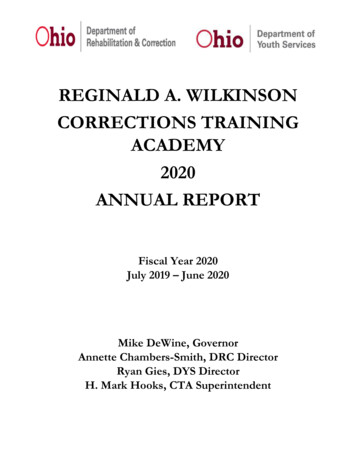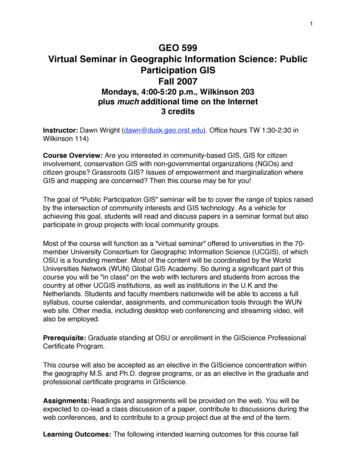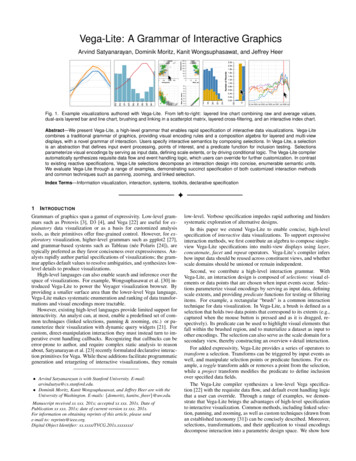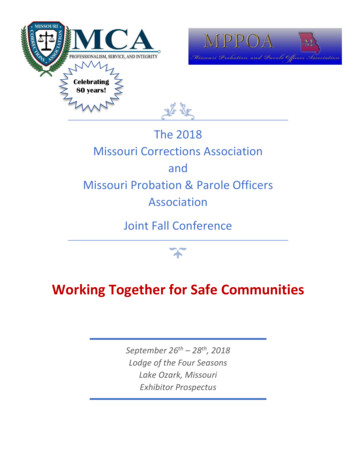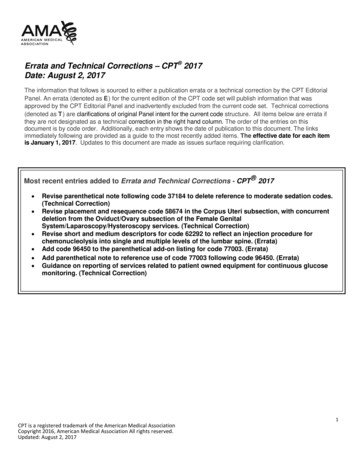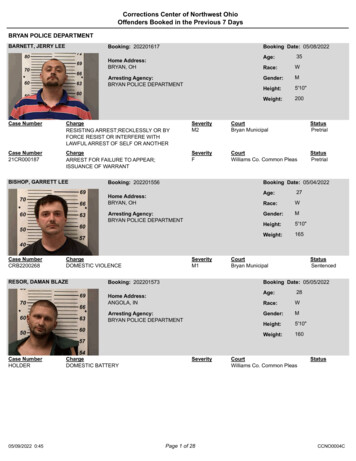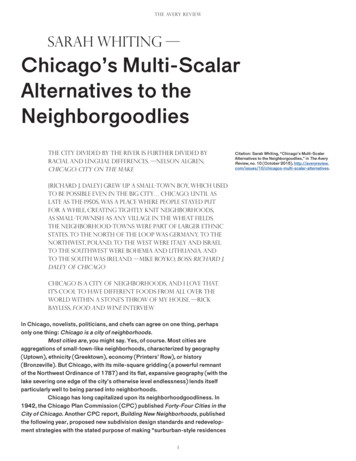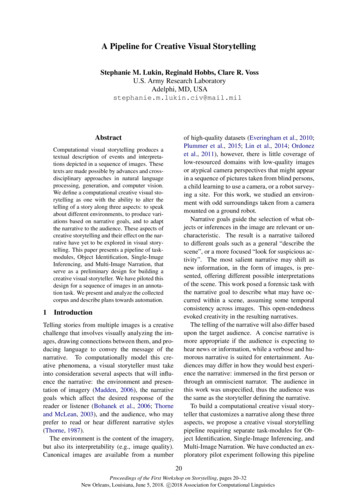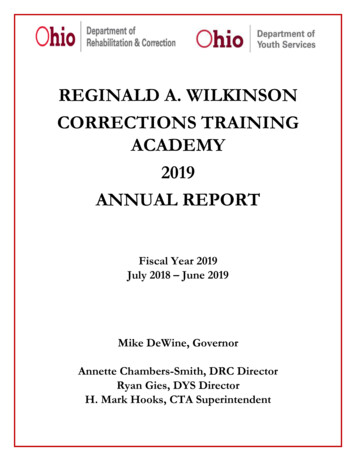
Transcription
REGINALD A. WILKINSONCORRECTIONS TRAININGACADEMY2019ANNUAL REPORTFiscal Year 2019July 2018 – June 2019Mike DeWine, GovernorAnnette Chambers-Smith, DRC DirectorRyan Gies, DYS DirectorH. Mark Hooks, CTA Superintendent
Table of ContentsReginald A. Wilkinson Training Academy . . 3Administration 4Activities and Accomplishments . 4Personnel Updates . 9CTA Operations . . 11Activities and Accomplishments . 11FY19 Operational Facts . 12Business Office . 13DRC Curriculum Development . 14E-Learning Overview 14FY19 Defensive Tactics Subject Control . . 14FY19 Use of Force 14FY19 Instructional Skills . . . 14Developing a Curriculum . . . . . 15Policy Administration 15FY20 Training Requirements . 15ACA Coordination 15DRC New Employee Orientation 16Activities and Accomplishments . . 16NEO Level 3 Evaluations . 16Statistics 17DRC Field Support 19General Activities . 19Statistics 19Annual Needs Assessment 20DYS Continuing Education Units . 23CEU Data . 23DYS Pre-Service & Field Support 24Pre-Service Onboarding 24In-service . 24
Reginald A. Wilkinson Corrections Training AcademyThe Reginald A. Wilkinson Corrections Training Academy (CTA) provides quality training andcustomer service to employees of the Department of Rehabilitation and Correction (DRC), theDepartment of Youth Services (DYS), and agency partners. CTA’s dedicated staff is responsible forthe development, coordination, and implementation of training sessions that provide students withindividual and professional development opportunities through DRC’s New Employee Orientation(NEO) program, DYS’ Preservice program, and the required and specialized in-service trainings forboth agencies. CTA also hosts a wide variety of trainings and special events.The curricula for NEO, Preservice, and In-service programs are developed based on the needs ofstaff in the field as identified through training assessments, agency updates, and suggestions fromstaff and agency leadership. Annually, CTA offers numerous e-learning courses and continues toexpand its program offerings based on the identified needs of our stakeholders. Curricula isdeveloped and enhanced through collaboration with DRC’s statewide Training Advisory Council(TAC), the National Institute of Corrections (NIC), and other correctional and outside criminaljustice professionals.Both, DRC’s NEO and DYS’s Preservice programs are required for all staff beginning their careerswith both agencies and the private institutions that DRC is partnered with. The objective of theseprograms is to prepare staff to be confident and competent in their jobs and to provide the agencywith employees who are better prepared to serve in a correctional environment.CTA offers a variety of specialized in-service training programs designed to complement annual inservice training while meeting the professional development needs of each employee. Specializedin-service programs are managed by CTA staff who consult with subject matter experts andinstructor trainers to develop, update, and improve these programs. The CTA In-Service CourseCatalog is a compiled listing of all specialized in-service trainings being offered by the academy on aquarterly basis. The course catalog can be accessed on the CTA intranet or DRC’s Internet.3
AdministrationActivities and Accomplishments During FY19, CTA continued to institute formal partnerships with colleges and universitiesand currently has 15 partnerships. On July 1, 2018, DYS changed their training year to the fiscal year calendar (July 1 – June 30)from the calendar year (January 1 – December 31), to be consistent with the trainingcalendar used by DRC. In November 2018, employees from DRC & DYS successfully completed the ExecutiveLeadership program. On March 22, 2019, DRC’s Training Advisory Council met at CTA and established theFY20 in-service training mandates based upon the recommendations submitted by agencyleadership and the results of the Annual Needs Assessment. May 7, 2019, CTA hosted the DYS Employee Recognition Ceremony.o Terrence Arthur of the Cuyahoga Hills Juvenile Correctional facility was selected asDYS’s Youth Specialist of the Year.o Alisha Rushing, Operations Manager, was selected as DYS’s Employee of the Year.o Bryan Weimerskirch, Senior Parole Officer, was recognized as DYS’s CommunityEngagement Liaison of the Year. May 10, 2019, CTA hosted the Ronald C. Marshall Correction Officer of the Year Banquet.o Aaron Rife of the Pickaway Correctional Institution was selected as DRC’s Officer ofthe Year.o The ceremony was attended by special guest, Governor Mike DeWine. In FY19, Superintendent Hooks proposed creating additional opportunities for DRC andDYS staff to develop their leadership skills beyond the existing track offered.o On June 17&18, 2019, CTA held its first John Maxwell Company leadership training(The 5 Levels of Leadership).o CTA will continue to bring back the Maxwell team for leadership trainings andworkshops to aid staff in their personal and professional development. The Internal Management Audit (IMA)/American Correctional Association (ACA) auditcycle was adjusted, moving the CTA IMA to July 30-31, 2019, and the ACA audit toSeptember 18-19, 2019. More detail will be provided in the FY20 Annual Report, but CTAdid receive 100% in all categories on both audits.*Due to DYS’s switch to the fiscal year calendar for their training cycle in July of 2018, all of the DYS informationprovided (with the exception of Business Office data) is based on an 18month time span that includes January 1 –June 30, 2018 to capture the 6 months not captured in previous annual reports.4
2018 Executive LeadershipFall 2018 Correctional Management5
DYS Employee Recognition Ceremony, May 7, 20196
DRC Memorial Ceremony and Correction Officer of the Year Banquet, May 10, 20197
John Maxwell’s 5 Levels of Leadership, June 17-18, 20198
Personnel Updates In FY19, changes were made to the position titles of CTA employees.o The four employees who supervise each of the four units at CTA are now referred toas Academy Unit Supervisors.o CTA’s Program Administrator 2 title was changed to Academy Training Developer.o A new classification was also developed, Academy Training Analyst, to create a careerstep between the bargaining unit Training Officer position and the exempt AcademyTraining Developer position. Mark Hooks, Superintendent came to CTA in April of 2019 after serving as Warden at RossCorrectional Institution for 5 years. Jason Rankin, Academy Training Analyst, was promoted to this newly created position afterserving as an Academy Training Officer for 2.5 years. Brian Young, Academy Training Analyst, came to CTA after working as a CorrectionOfficer at Southeastern Correctional Institution for 7 years. Dennis Franks, Training Officer, came to CTA after 7 years as a Correction Officer atSoutheastern Correctional Institution. Ashley Kerr, Training Officer, came to CTA after serving as a Correction Officer at BelmontCorrectional Institution and the Corrections Reception Center for 6 years. Troy Hott, Maintenance Repair Worker 3, comes to CTA after spending 14 years with OPIand serving the State of Ohio for 27 years. Clifton Chapman, Academy Training Developer, came to CTA after serving as a TrainingOfficer and Juvenile Corrections Officer at the Circleville Juvenile Correctional Facility. Deanna Clark, Academy Training Developer, came to CTA after working as an OperationsManger and a Juvenile Corrections Officer at the Cuyahoga Hills Juvenile CorrectionalFacility. Kelly Walkauskas, Technology Based Training Developer, came to CTA after serving as aDisability Claims Adjudicator II at Opportunities for Ohioans with Disabilities. Sarah Bowling, Technology Based Training Developer, came to CTA after working as aHearing Officer with the DYS Release Authority.9
As pictured from left to right: Mark Hooks, Bryan Young, Ashley Kerr, Dennis Franks & Troy HottAs pictured from left to right: Deanna Clark, Sara Bowling, Clifton Chapman & Kelly Walkauskas10
CTA OperationsActivities and AccomplishmentsIn FY19 the Oakwood building, which serves as the female dormitory, was renovated. Newflooring was installed in all the hallways and dorm rooms, as well as the common area. By installingwall dividers with doors, dorm rooms were redesigned to provide students with more privacy and aspace of their own during their stay. Each of the individual spaces have been outfitted with a newbed that also provides storage for personal items, an ottoman, and a desk with an LED desk lamp.The Briarwood and Beechwood buildings are in the process of receiving the same renovationupgrades as Oakwood.11
Additionally, CTA began a roofing project in FY19. CTA’s roofs were in serious need ofreplacement. In addition to the roofing, the fascia boards and exposed wood was replaced, and newmetal flashing and gutters were added to the Oakwood, Briarwood, Beechwood, and Pinewoodbuildings.CTA’s food service contract was up for renewal in FY19. AVI Food Systems was re-awarded thecontract through an open-bid process. With the quality service received from AVI in the past, welook forward to continuing working with them moving forward.FY19 Operational Facts 56,107 meals were served to CTA students. CTA is responsible for the maintenance of 60 acres.12
Business Office CTA received 523,773.32 in revenue for external training fees. CTA collected 4,090.90 in recycling funds.CTA Budget Fiscal Year 2019DRC BudgetGRF/500/503321 PayrollGRF/500/504321 PayrollTotal Payroll 535,458.34 2,747,951.40 504321Total GRF Budget 75,172.17 298,822.61 462,520.80 120.00 433,085.43 12,849.38 Total 5710 Budget 4,125.00 131,950.00 337,925.00 131,864.00 605,864.005AF0/520/501609/5000CTotal 5AF0 Budget 3,381.00 3,381.00Total FY2019 DRC Budget 5,175,225.13DYS 530/470401/5800CTotal FY2019 DYS Budget 17,655.00 191,645.00 19,400.00 228,700.0013
DRC Curriculum DevelopmentE-Learning OverviewCurriculum Development staff created several new courses for CTA, including: 702 Web-Based Training (WBT) NEO exams 44 WBT courses for in-serviceo Out of the 44 WBT courses, 20 were developed for FY19 trainingrequirements.o There were 227,052 employee completions of DRC WBT courses, for a total of113,256 training hours. Enterprise Learning Management (ELM) Agency Administrators created a total of14,468 Instructor Led Training (ILT) activities with 489,079 staff enrollments in theseILTs. There was a total of 1,051,020.49 ILT hours.FY19 Defensive Tactics Subject Control (DTSC)The following courses were conducted Four DTSC Instructor courses were held at CTA. One Edge and Blunt Weapons class was conducted. One Weapon Retention class was conducted.FY19 Use of Force (UOF) Created the FY20 training requirement for the UOF end user lesson plan. Held four UOF Instructor classes at CTA.FY19 Instructional Skills Nine 40-Hour Instructional Skills courses were conductedo Eight classes were conducted at CTA.o One class was conducted at a regional location.o 207 students successfully completed the class. Five 8-Hour Instructional Skills courseso Four classes were conducted at CTA.o One class was conducted at a regional location.o There were 62 students who successfully completed the class. Eight Instructor Trainers were developed for the Instructional Skills program. An Instructor Trainer meeting was held to revise the curriculum for both the 40-Hourand 8-Hour Instructional Skills courses.o Changes were made and pre-requisite e-Learning courses were developed forboth courses to allow more time for students to practice facilitation skills in theclassroom.14
Developing a Curriculum (DACUM)The Curriculum Development staff conducted a DACUM with eight DRC and DYS leadersto aid in the creation of a new leadership track.Policy Administration Curriculum Development staff assumed the duties of managing the 39-TRN-series and 38CED-06 policy. All CTA owned policies were reviewed and implemented by July 29, 2019 Significant revisions noted for 39-TRN-04 Training Lesson Plans and 39-TRN-14Leadership Training. Two new lesson plan templates (Traditional & Instructional Theory into Practice) werecreated to update and replace the previously used lesson plan template and placed in theshared folder.FY20 Training RequirementsCurriculum Development staff created, assisted in the creation of, and/or reviewed requiredtrainings for the below FY20 topics. Active AggressorCritical Incident ManagementDrug IdentificationSecurity Threat GroupsStaff WellnessAPA Transport, Arrest Search and Seizure (revised)APA Field Tactics (revised)Worked with field training staff to create site-specific trainingIn-person Training for Trainers was conducted in multiple locations for the above listedcourses.ACA Coordination Curriculum Development staff assumed the duties of IMA/ACA accreditation coordinationfor CTA. An Internal Management Audit did not occur in FY19 as the IMA date was moved back toJuly 30-31, 2019.15
DRC New Employee OrientationActivities and AccomplishmentsThe NEO training provides all new hires with a foundation of departmental policy and procedure.All new hires must successfully complete a total of 120 hours of training at CTA. All newcorrection officers attend an additional 40 hours of firearms, transportation, and OC training.Healthcare staff attend an additional 24 hours of training.CTA constantly strives to ensure new hires are receiving the most up-to-date, relevant informationto prepare them to be confident and competent in their jobs.In FY18, 8.5 hours of scenario-based training was added to the NEO curriculum. In early 2018, alevel three evaluation was conducted to assess the effectiveness of the new learning method.NEO Level 3 Evaluations and Focus GroupsThe Corrections Training Academy trains approximately 1,600 new staff per year. CTA strives toensure we are meeting the needs of the new hires and the facilities/worksites. An Annual NeedsAssessment via an online survey is conducted along with course evaluations, focus groups, andinterviews with supervisors to collect data to be analyzed and applied to the New EmployeeOrientation curricula. The following is an overview of the method and an overview of the datacollected from January 2017 to January 2018.Level 3 Survey:The survey was designed to gather information regarding the new hire’s experience at CTAas well as with the On-Job Training (OJT) conducted at the worksite.Survey Recipients:712 staff (started NEO between 1-2018 and 9-2018)Respondents:162 total staff responded (23%)Correction Officers:Medical Staff:Mental Health Staff:Parole Officer:Other:114221196Question: Overall, do you feel you received enough training in NEO to adequatelyperform your job duties?Yes: 87% (140)No: 13% (22)16
Question: On a scale of 1 to 5, how would you rate your overall experience with yourOJT coach? Superior/Good: 42% (68) Very poor/poor: 58% (94)Common Suggestions to improve the OJT program: Additional time spent on OJT: 24% (39) More scenario-based training: 34% (55) Train on every shift:Action Taken:Determined by eachfacility9% (14)Focus Groups:NEO staff conducted six focus groups with facility staff and select employees that werehired and completed NEO between January 2017 and December 2017.Dates: March- July 2019Participants: 140 invited/65 participatedRepresentation: 19 DRC facilitiesThe focus group participants were selected by each facility. The only requirement was thatthey were a probationary employee, having completed NEO within the timeframe of January2018-December 2018.The purpose of the focus groups was to determine if/how the information the new hireslearned in NEO was able to be applied to their job upon return to their worksite. The focusgroup participants were asked to identify the main topics (i.e. performance objectives) a newhire needs to know or be able to do upon return to their worksite.Based on the feedback received from the participants, the current NEO curricula coversmost of the main topics and what the staff member needed to know. The need toincorporate scenario-based/hands-on training exists and was discussed at length with thefocus groups.During the focus groups we also asked various questions about their employment up to thispoint seeking common themes.StatisticsThe North Region facilities hired a total of 731 employees.o 579 custody staffo 112 non-custody staff17
The South Region facilities hired a total of 669 employees.o 585 custody staffo 84 non-custody staffThe APA North Region hired a total of 16 staff members, while the APA South Region sawthe addition of 21.CTA conducted 26 NEO classes in FY19. The average class size for FY19 was 65 studentsconsisting of DRC and private prison personnel.18
DRC Field SupportGeneral ActivitiesCTA’s Field Support unit is responsible for the oversight of the in-service training activitiesoccurring in the field (i.e. institutions, Division of Parole & Community Services, and theOperation Support Center) throughout the fiscal year.Staff in the Field Support unit assisted with and coordinated the following: The development of all Training Plans for institutions, Adult Parole Authority (APA)regions, Operation Support Center, and the Corrections Training Academy staff. Synchronized regional Use of Force training for trainers. Directed site visits at assigned institutions and APA regions. Conducted Internal Management Audits for ACA and Ohio training standards. Assisted with APA Region Audits.o Delivered support in the development and implementation responses toinspection non-compliance. Participated with the training officer interview panels and selection process forinstitutions.o Aided institutions with application screening and reviews for training officerpositions. Completed annual policy reviews. Served as Regional Training Advisory Council chairpersons.StatisticsOhio has 28 prisons located through the State that are grouped into 3 regions foradministrative purposes.The North Region consists of the following 9 prisons: Allen/Oakwood CorrectionalInstitution (AOCI), Belmont Correctional Institution (BECI), Grafton CorrectionalInstitution (GCI), Mansfield Correctional Institution (MANCI), Marion CorrectionalInstitution (MCI), Ohio State Penitentiary (OSP), Richland Correctional Institution(RICI), Trumbull Correctional Institution (TCI), and Toledo Correctional Institution(TOCI).The South Region consists of the following 10 prisons: Chillicothe CorrectionalInstitution (CCI), Lebanon Correctional Institution (LECI), London CorrectionalInstitution (LOCI), Madison Correctional Institution (MACI), Nobel CorrectionalInstitution (NCI), Pickaway Correctional Institution (PCI), Ross CorrectionalInstitution (RCI), Southeastern Ohio Correctional Institution (SCI), Southern OhioCorrectional Facility (SOCF), and Warren Correctional Institution (WCI).19
The Specialty Region consists of the following 9 prisons: Correctional Reception Center(CRC), Dayton Correctional Institution (DCI), Lake Erie Correctional Institution(LAECI), Loraine Correctional Institution (LORCI), North Central CorrectionalComplex (NCCC), Northeast Ohio Correctional Center (NEOCC), NortheastReintegration Center (NERC), Ohio Reformatory for Women (ORW), and FranklinMedical Center (FMC).CTA’s Field Support staff provides oversight of field training through the collection of datathat is compiled through the Annual Needs Assessment, reports from the electronic learningmanagement system, and self-reports by facility training officers and APA assistant regionaladministrators. The data gathered includes the number of newly hired employees, attendanceof mandated 40-hour in-service training courses, by region, the number of bargaining unitstaff promoted to exempt positions and physical skills recertifications. These metrics madeavailable by the ELM Fiscal Year Report and self-reported by the institutional trainingofficers and the APA assistant regional administrators.Annual Needs Assessment:The Annual Needs Assessment is a compilation of DRC staff, wardens, regionaladministrators, and TAC members’ feedback from the distributed survey. This informationwas compiled and used to create the FY20 training requirement letter that was distributed sothat field training professionals and managing officers could create training plans for eachsite to include these required courses and other necessary site-specific trainings. Thesetrainings are implemented through annual in-service training at each worksite.At the time of the FY20 Annual Needs Assessment, DRC’s institutions were divided intofour regions (NE, NW, SE, and SW). For the purposes of this data, there are two identifiedregions (North and South) with the Specialty Region being split between the two. Data from LAECI, LORCI, NCCC, NEOCC, and NERC is included in the NorthRegion. Data from CRC, DCI, and FMC is included in the South Region.North Region Facilities Promotionso A total of 40 staff members within the North Region were promoted fromunion to exempt positions.20
South Region Facilities Promotionso A total of 40 staff members in the South Region were promoted from union toexempt positions.APA North RegionThe APA North Region includes the Akron, Cleveland and Lima APA offices. Promotionso A total of 2 staff members were promoted from union to exempt positions.21
APA South RegionThe APA South Region includes the Cincinnati, Columbus, and Dayton APA offices. Promotionso A total of 4 staff members were promoted from union to exempt positions.22
DYS Continuing Educating Units (CEUs)CEU DataThe Training Academy is responsible for continuing education unit (CEU) coordination forODYS. This process involves obtaining and reviewing curricula, securing approval, andmaintaining electronic records.Due to the DYS training cycle changing to the fiscal year calendar in FY19, the data collectionperiod represented spans from January 2018 through June of 2019, to encompass the six months ofinformation prior to the change of the training cycle. There were 23 trainings that were approved for CEU’s in 5 content areas:o psychology, social work, counselor, substance abuse and marriage and family therapy. At total of 556 certificates were issued to ODYS staff and allied professionals for a total of3,411.5 hours.23
DYS Pre-Service & Field SupportPre-service OnboardingThe CTA Pre-Service training program was offered 10 times in the FY 19 training cycle with classsizes ranging from 17-44.From January 1, 2018 to June 30, 2019, 287 new employees attended DYS’s basic training program. The average number of training hours completed by each student during Pre-Service is 126hours.o There were a total of 17,443 pre-service training hours January 1, 2018 to June 30,2019.In-serviceFrom January 1, 2018 to June 30, 2019 DYS employees completed 51,602.5 hours of in-service training. There were a total of 22,949 enrollments in in-service training.Total # Training Hours Provided by CTATotal # of EnrollmentsTotal # of Pre-Service Training HoursTotal # of In-Service Training Hours69046.22323617443.751602.524
DYS staff to develop their leadership skills beyond the existing track offered. o On June 17&18, 2019, CTA held its first John Maxwell Company leadership training (The 5 Levels of Leadership). o CTA will continue to bring back the Maxwell team for leadership trainings and workshops to aid staff in their personal and professional development.
